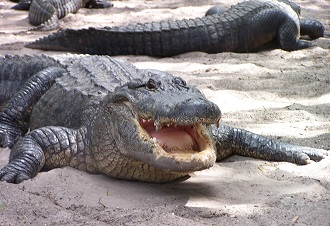
Comparing the Movement of Crocodiles, Alligators and Caiman
RVC experts in the movement of various species have found that different crocodilian species – such as crocodiles, alligators and caiman – have very different tendencies when it come comes to galloping.
Challenge
Those who work closely with crocodilian species, such as in zoos and wildlife centres, had noticed over time that crocodiles, alligators and caimans move in different ways, especially when it comes to galloping – which is generally associated with horses.
The team at the RVC’s Structure and Motion Laboratory have been conducting research into the movement of many different species for several years. They have applied their expertise to examine exactly how these different crocodilian species move.
An RVC led scientific study, conducted at St Augustine Alligator Farm and Zoological Park in Florida, was able to formalise observations made by those who work with crocodilian species and develop explanations for why these different species move the way that they do.

Solution
To examine the differences in how the different species move, RVC researchers set up video cameras at the St Augustine Alligator Farm and Zoological Park, and, working alongside experts from that organisation, studied the gaits and speed of 42 individuals from 15 species of crocodylia.
The researchers found that, as expected, larger crocodylia moved relatively more slowly, with athletic ability decreasing as size increases. However, while many popular and scientific accounts previously assumed only a few species of crocodiles could gallop and bound, the researchers discovered that a further five species can in fact do so, including the critically endangered Philippine crocodile. This means that it is now known that at least eight crocodile species can gallop and bound.
The researchers also found that despite the difference in gaits used, crocodiles and alligators can all move at about the same speed – no more than 11 miles per hour. They concluded that the ability to gallop (and to use an even more extreme gait called a bound) is likely down to the size and build of the crocodylia in question as well as their strategy in relation to dangers.
Following the study, Professor John Hutchinson, a specialist in evolutionary biomechanics at the RVC and study lead, commented: “We were really surprised at one major thing: despite the different gaits crocodiles and alligators use, they all can run about as fast. So why do some crocodiles choose to gallop? We suspect that bounding and galloping give small crocodiles better acceleration and manoeuvrability, especially useful for escaping from danger. It seems like alligators and caiman stand their ground rather than run away with an extreme gait.”
Impact
In addition to their importance for basic understanding of maximal performance in crocodylia, these findings have implications for bone safety factors (ratios of failure stress to peak in vivo stress). Past experimental assessment of bone safety factors has made important contributions towards understanding crocodilian functional design but may have underestimated safety factors at maximal performance and, thus, deserves some re-evaluation.
It is possible that the limb bones of crocodylia are not as “overbuilt”, as previously inferred, because those calculations were based on locomotor speeds and gaits that impose lower stresses on the bones, thereby reflecting local maximum bone stresses of that given speed/gait rather than the absolute maximum (‘peak’) stresses for a species/individual.
Partners and Funders
St Augustine Alligator Farm and Zoological Park
This study was funded in part by a grant from the European Research Council.
Publications
| Title | Publication | Year |
| Divergent evolution of terrestrial locomotor abilities in extant Crocodylia | Scientific Reports | 2019 |
